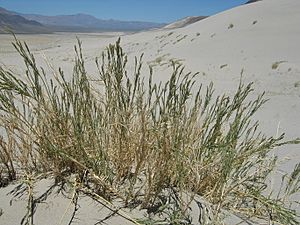Eureka dunegrass facts for kids
Swallenia is a very special and rare type of plant. It's a kind of grass that you can only find in one place: Death Valley National Park in California.
The only known species of this grass is called Swallenia alexandrae. People often call it Eureka dunegrass or Eureka Valley dune grass. This unique grass was named after an American botanist named Jason Richard Swallen (who lived from 1903 to 1991). The species part of its name, alexandrae, honors Annie Montague Alexander, an American who loved collecting fossils and helping good causes.
Quick facts for kids Eureka dunegrass |
|
|---|---|
 |
|
| Conservation status | |
| Scientific classification | |
| Genus: |
Swallenia
|
| Species: |
alexandrae
|
| Synonyms | |
|
|
What Does This Rare Grass Look Like?
Swallenia alexandrae is a tough, clumpy grass that grows in sand. It has thick underground stems called rhizomes. These rhizomes help the plant spread and stay strong in the sandy soil.
Its stems stand up straight and are quite stiff. The leaves are sharp, and its pale-colored flowers grow in a cluster called a panicle. These features help scientists identify this special grass.
Where Does the Eureka Dunegrass Live?
This rare plant is found only in Inyo County, California. It lives on a single, isolated group of sand dunes. These are the Eureka Valley Sand Dunes in the Mojave Desert. All of this special habitat is located inside Death Valley National Park.
Why Is This Plant Endangered?
The Eureka dunegrass is listed as a threatened species by the United States government. This means it is at risk of disappearing forever if we don't protect it.
The biggest danger to this grass used to be off-roading. Off-road vehicles would drive over the dunes and crush the plants. Luckily, off-roading is no longer allowed where the grass grows. However, people who trespass (go where they shouldn't) with off-road vehicles or campers can still harm the few remaining groups of this grass. Protecting its home is very important for its survival.


